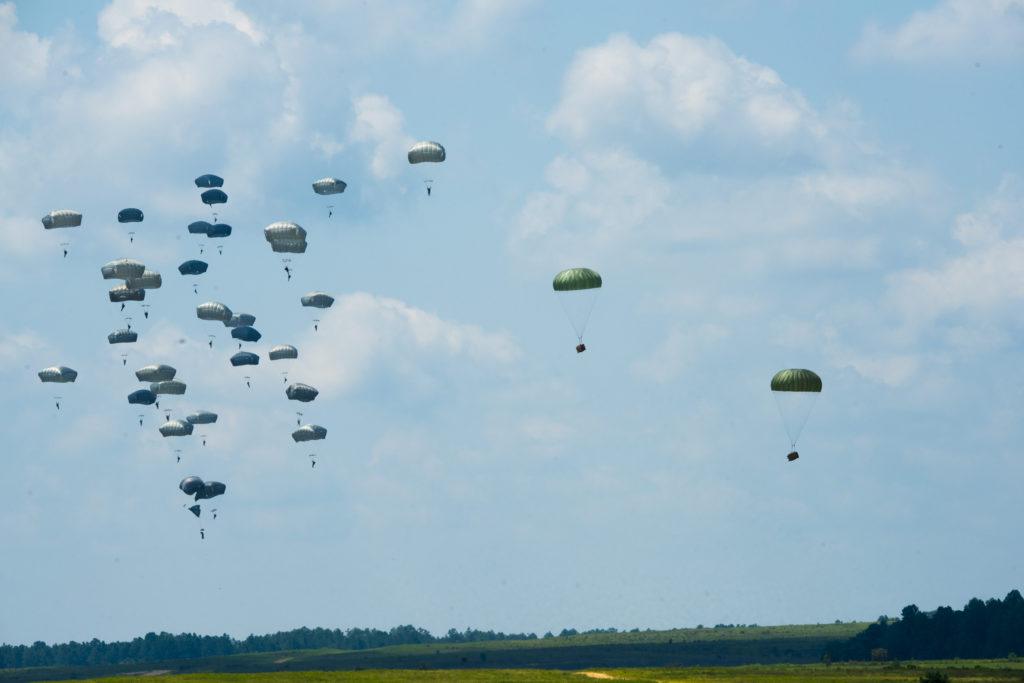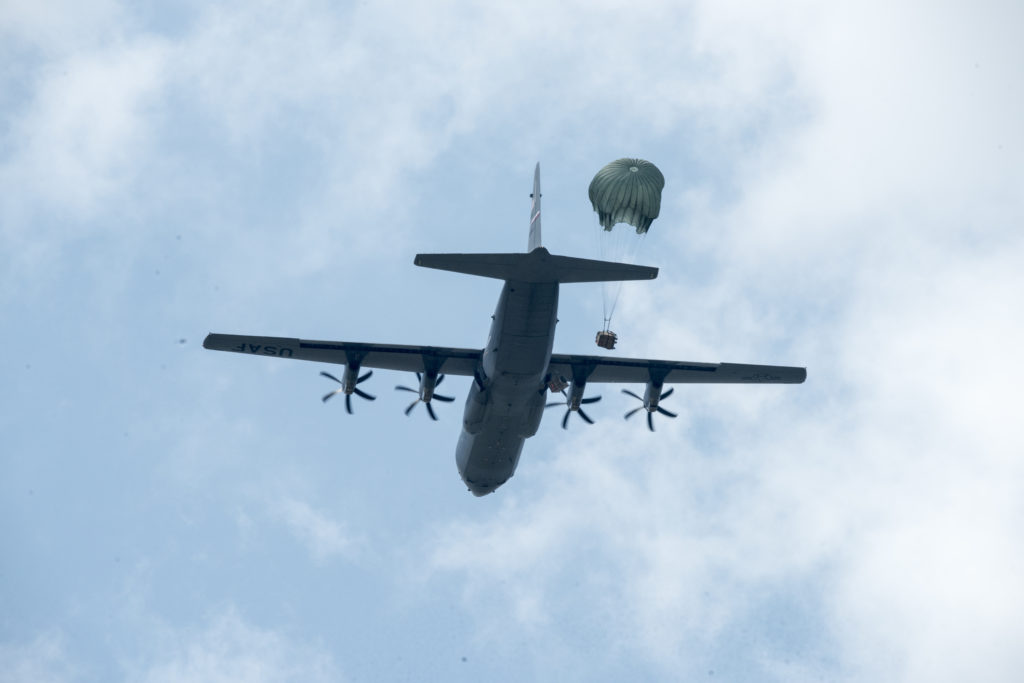By Mr. James (JC) Cochran, Military Test Plans Analyst, Airborne and Special Operations Test Directorate, U.S. Army Operational Test Command
(Editor’s note: The Airborne drop test in the article below was conducted before COVID19 ramifications were fully understood. The U.S. Army Operational Test Command continues developing and planning equipment testing operations to ensure all advances the Army is making in modernizing the force. Along with our acquisition and testing partners, we remain connected so we can integrate and analyze information to defeat new threats while retaining overmatch.)
FORT BRAGG, North Carolina — 82nd Airborne Division paratroopers here recently wrapped up another test of the Caster Assisted A-Series Delivery System (CAADS), using U.S. Air Force C-130 aircraft, to deliver mission essential supplies and munitions to ground troops.
Soldiers from Company A, 2nd Battalion, 325th Airborne Infantry Regiment, 2nd Brigade Combat Team, teamed up with subject matter experts from the U.S. Army Advanced Airborne School.
With the U.S. Army Operational Test Command’s Airborne and Special Operations Test Directorate (ABNSOTD), Airborne Troops successfully rigged, dropped, and recovered the CAADS door bundles during operational testing on Sicily Drop Zone.
“We believe the American Warfighter deserves the very best equipment to fight and win our Nation’s wars,” said Col. Brad Mock, ABNSOTD director. “ABNSOTD provides this by informing fielding decisions through independent air transportability operational testing.”
“Leaders of units involved in testing have to consider new systems, which may also drive changes to operations and doctrine,” said Mr. Wayne Lovely, a test officer with ABNSOTD.
The CAADS is specifically designed to increase the number of door bundles that can be rapidly deployed from a C-130 aircraft while reducing deployment time.
Airdrop operations of the CAADS demonstrated its safe deployment of door bundles using CAADS to improve the movability of personnel deploying the bundles, reducing exit times and allowing an inserted number of paratroopers to successfully exit.

“Tests are unit-led, which translates into coordinated control under realistic operational environment scenarios,” said Staff Sgt. Mckayla Bailey, 108th Air Defense Artillery Brigade.
“I consider CAADS to be an asset. It makes moving large loads out of the paratroop door an easier task. It seems to work faster than typical door bundles.”
Sgt. Eric Bour, of the 20th Engineer Brigade, said, “I like the capability of dropping heavy loads without burdening my jumpers.
“Being a Combat Engineer, breaching equipment, demolition, and other special equipment can be cumbersome, however, three per paratroop door eats a proportionately large amount of green light, and may limit my ability to maximize personnel in the aircraft.“

ABNSOTD’s chief of airborne testing said his outfit exists to serve both Soldiers and the Airborne community.
“Operational Tests are a critical piece of the acquisitions process,” said Maj. Cam Jordan. “These tests give our Soldiers an opportunity to improve and use future capabilities.”
“The Army is investing and testing now to modernize our force to meet evolving current and future operational demands,” said Mock.
“Even though we are more than capable of defending on today’s battlefield, getting systems such as the CAADS to the force greatly tips the scales to our favor.”
Mock also said operational readiness is a key factor in testing airborne equipment.
“We ‘Test for the Best’ by conducting rigorous, realistic, honest, service-unique and joint testing, making sure that the systems developed are effective in a Soldier’s hands and suitable for the environments in which our Soldiers in today’s Army train and fight,” he said.
~~
About the U.S. Army Operational Test Command:
The Fort Bragg, North Carolina-based ABNSOTD plans, executes, and reports on operational tests and field experiments of Airborne and Special Operations Forces equipment, procedures, aerial delivery and air transportation systems in order to provide key operational data for the continued development and fielding of doctrine, systems or equipment to the Warfighter.
The U.S. Army Operational Test Command is based at West Fort Hood, Texas, and its mission is about ensuring that systems developed are effective in a Soldier’s hands and suitable for the environments in which Soldiers train and fight. Test units and their Soldiers provide feedback, by offering input to improve upon existing and future systems with which Soldiers will ultimately use to train and fight.

